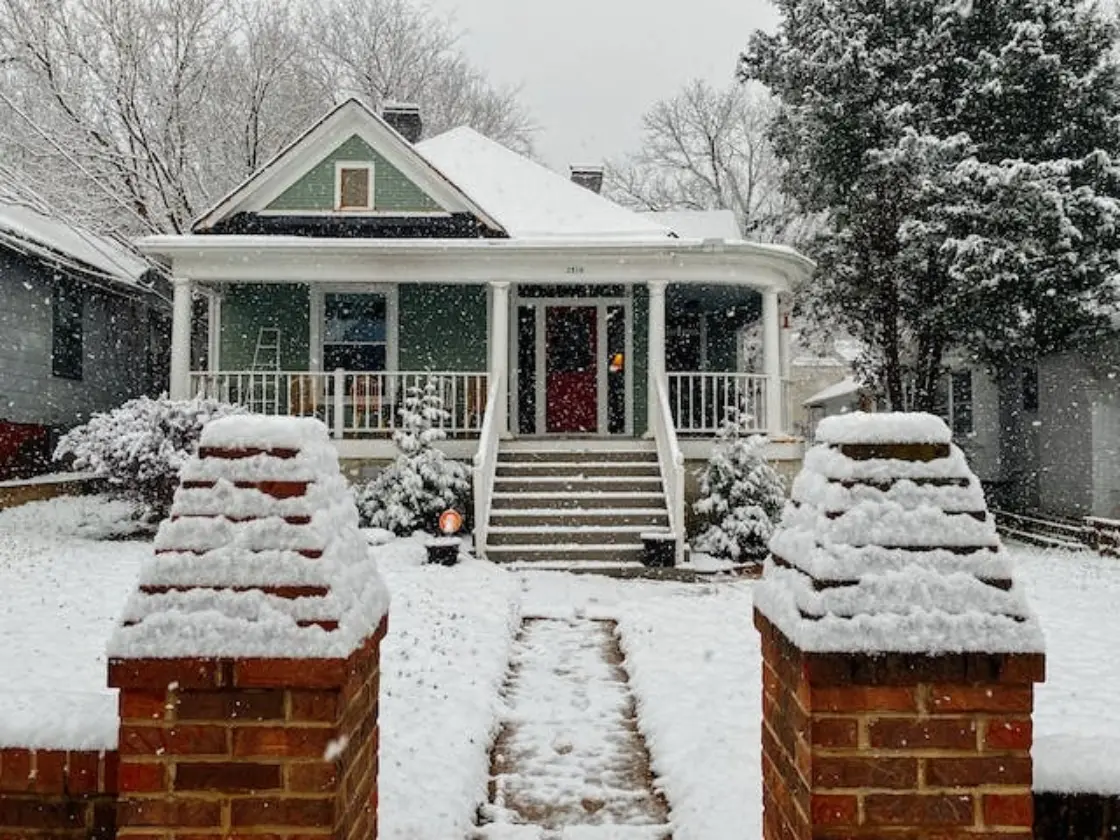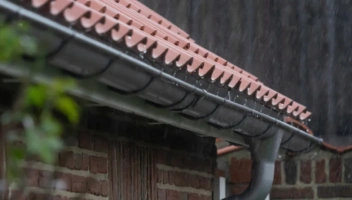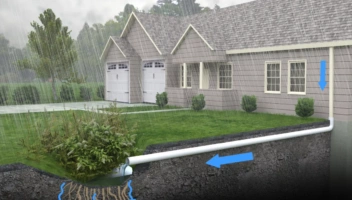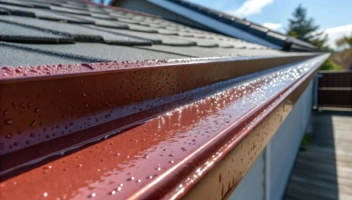Winterize Your Gutters: How to Prepare for Snow & Ice

During the winter, falling debris, snowfall, and freezing temperatures increase the chances of clogged gutters. In turn, clogged gutters can lead to water seeping into your roof or walls—and for many, an increased opportunity for ice dams to form. That’s why now’s the time to winterize your gutters.
Can you install gutters in the winter? How can I keep my gutters from freezing over in the colder months?
We often field these and similar questions from homeowners on our social media pages, and we’re happy to help! Our team of experts has put together this quick reference guide on winterizing your roof and gutters.
In this article:
- Should You Take Down Gutters in the Winter?
- What Are Ice Dams?
- Should You Remove Gutter Guards in the Winter?
- How to Winterize Your Gutters to Prevent Ice Dams
- How to Keep Gutters From Getting Damaged by Snow
- Is It Normal for Gutters to Freeze in the Winter?
- How to Keep Your Gutters From Freezing
- Benefits of LeafFilter in Snowy Climates
- Final Thoughts
- Frequently Asked Questions on How to Winterize Your Gutters
Should You Take Down Gutters in the Winter?

Photo by Sergey Platonov from Pexels
Gutters are essential to the upkeep of your home, diverting water away from the most vulnerable parts of your house, like the roof and foundation. When spring showers arrive, snowmelt becomes an issue.
The absence of gutters could cause all sorts of problems, from soil and landscape disturbances to significant issues like basement flooding, damage to your home’s foundation, and other water damage. .
Often, we find that homeowners believe they should remove their gutters in the winter, usually because they’re concerned about the formation of ice dams. While clogged gutters can cause water to overflow and freeze in the winter, gutters do not cause ice dams.

Gutter problems often become more visible in the winter.
With the weight of snow and ice, some gutter systems may sag or even rip away from the home. Pictured here is an ice dam, a common condition seen across homes in snowy regions.
What Are Ice Dams?
Ice dams are massive sheets of ice that form near the edge of a roof. While it’s easy to assume ice-covered gutters are responsible for ice dams, they are not the cause.
Poor insulation and a loss of heat within the roof cause ice dams. Gutters are not typically heated, so this is often the portion of the roof that is coldest.
As snow melts and slides down the roof, it freezes upon reaching the colder sections. Winterizing your roof and gutters is essential to preventing ice dams.
Should You Remove Gutter Guards in the Winter?

Photo by northlight from Shutterstock
The short answer is: it depends, but generally no. If you have an effective gutter guard solution installed, there’s no need to remove them in the winter. In fact, removing gutter guards that are capable of holding up to and performing in winter weather may actually be detrimental.
That’s because removing your gutter guards leaves your gutters vulnerable to debris buildup, frozen debris, and the formation of clogs. Clogs inside your gutters create a domino effect of issues that ultimately can damage your roof, your siding, your interior walls, your home’s foundation, and even the landscaping surrounding your home.
On the other hand, if you have poor-quality gutter guards, they may bend or warp under the weight of heavy snow and ice. This can damage your gutters and cause them to separate from your roof, resulting in roof damage. In this case, not only do you have the same potential issues as you’d have without gutter guards, but you also have to deal with repairing or replacing your gutters and potentially your roof.
The best solution is to invest in a proven, durable gutter protection system and leave your gutter guards in place throughout the winter while taking the proper steps to winterize your gutters.
How to Winterize Your Gutters to Prevent Ice Dams

Photo by Suzanne Tucker from Shutterstock
Ice dams form at the mercy of environmental factors, including air that is below freezing and a thick layer of snow on the roof. Take a few simple steps to minimize the formation of ice dams.
1. Clear Out Gutter Debris
If your gutters are full of leaves, sticks, and other debris, they cannot drain water running down the roof. Gathered water will inevitably freeze, adding weight and wear to your gutter system.
Keeping them clean helps to keep them flowing through the winter and prevent clogs from forming inside your gutters.
2. Properly Insulate Your Attic
Increasing the amount of insulation in an attic space can help prevent heat loss. Less heat loss means lower utility bills and less snow melting on the roof. And less snow melting means less water freezing on roof edges and gutters.
3. Apply Heat Tape to Your Gutters
You could also consider heat tape, also called heating cables, which can cause ice dams to melt. However, they’re notoriously ineffective in snowy climates.
The cycle of freezing and melting snow can cause ice dams to become even more problematic. Shingles may become damaged, and heat cables can elevate the risk of an electrical fire.
4. Consider Alternative Roofing Materials
A less common—but equally effective—method to winterize gutters is upgrading to a smoother roofing style, like a metal roof. A metal roof can prevent a thick, fluffy layer of snow from settling on the roof and freezing.
Keep in mind this requires long-term planning and budgeting. Metal roofs often come with a high price tag, but they also have a longer lifespan than traditional roof styles.

Photo by ND700 from Shutterstock
Unprotected gutters may be damaged in the winter months.
Snow and ice can weigh upon gutters, causing potential damage. Here, a clogged, overflowing gutter has warped under the weight of heavy icicles.
How to Keep Gutters From Getting Damaged by Snow
Did you know that LeafFilter's micro-mesh screen is made of surgical-grade stainless steel? 💪 This material can withstand the toughest weather and the heaviest debris. Get the facts at https://t.co/rsIPpXXKiS #LeafFilter #HeavyDuty #DurableMaterials pic.twitter.com/VEw95qLhw1
— LeafFilter Gutter Protection (@LeafFilter) June 14, 2023
Not all gutter protection is created equal when it comes to winterizing gutters. DIY solutions like screens, brushes, and foam gutter guards can often collapse or freeze under the weight of snow and ice.
Plus, cheap building materials may become brittle and crack as temperatures fluctuate. However, quality products like LeafFilter are designed to reduce winter worries and give you peace of mind with top performance. Our patented gutter protection solution has a durable uPVC frame and is installed with internal structural supports to strengthen the guards and your home’s gutters.
Is It Normal for Gutters to Freeze in the Winter?
It’s common for gutters to freeze if they’re not clear of debris or protected with a gutter protection system. However, it’s not really normal, nor is it something you can take lightly should it happen.
If there’s debris buildup inside your gutters, it may block the flow of melting snow and ice, resulting in water retention. When temperatures drop, the retained water freezes, adding extra weight to your gutters.
The added weight can cause your gutters to bend, warp, and break away from your roof, which may damage your roof. Additionally, frozen gutters trap snow and ice on the surface of your roof, which can damage or loosen your shingles, weaken your roof, and cause leaks inside your home.
How to Keep Your Gutters From Freezing
If your gutters are cleaned out and flowing, you can rest easy. Often, clogs inside your gutters are a major cause of wintertime issues. In many freezing environments, snow will gather inside and on top of your gutters no matter what you do.
If you can easily reach your gutters, walking around the home with a broom and brushing snow off of them is a quick and easy way to minimize the risk of ice formation.
Additionally, ensuring your gutters are properly pitched and free of any leaks, cracks, or other concerns is essential to keeping them in proper working condition.
Benefits of LeafFilter in Snowy Climates
With our #LifetimeWarranty, you can trust that your LeafFilter Gutter Protection will work at #peakperformance all year round! 📅 Invest in your home's protection today! 🏠 #LeafFilter #GutterProtection #ClogFree #HomeProtection #HomeOwnershipMonth pic.twitter.com/7XlFZREtuI
— LeafFilter Gutter Protection (@LeafFilter) June 3, 2023
Our corporate headquarters is located in the Lake Erie snowbelt, so we know a thing or two about heavy snow! Here’s why LeafFilter gutter guards are an excellent option for homes in snowy climates:
- Strength & Durability: Internal hidden hangers provide added strength to your gutter system, diminishing the risk of your gutters buckling or sagging under the weight of heavy snow and ice.
- Innovative Design: Snow will sit on top of your gutter guards instead of inside the gutter, creating a pocket of air. As the air around the gutter system melts the snow, meltwater passes through your gutter system and diverts away from your home.
- Keeps Debris Out: By keeping your gutters clear and clog-free all year round, our award-wining gutter protection system ensures your gutters are prepped to perform as soon as the snow begins to melt.
Final Thoughts
Many homeowners opt to wait until spring to address gutter problems. But winterizing your gutters at the start of winter minimizes new gutter problems in the spring. Keeping your gutters clean of debris, ensuring proper insulation, and installing gutter guards, like LeafFilter, minimizes ice dams and potential gutter, roof, and home damage.
LeafFilter is here to help year-round, even in the coldest months. You can schedule your free estimate today to take advantage of our winter schedule.
Do you have a question? Connect with us on Facebook to keep the conversation going and to learn more about LeafFilter Gutter Protection.
Frequently Asked Questions on How to Winterize Your Gutters

What can I put in my gutters to keep them from freezing?
Sprinkling sodium chloride (salt) in your gutters can help to prevent them from freezing. However, we don’t recommend using rock salt, ice melt, or other chemical solutions in your gutters because they can damage your gutters and shingles.
Installing heat tape inside your gutters is another potential solution. Heat tape keeps your gutters warm, melting snow and ice as it falls into them and preventing melted ice and snow from refreezing.
However, we advise against putting heat tape inside your gutters, as it can increase the risk of an electrical fire. There’s also a risk of heat tape contributing to the formation of ice dams due to the freezing-melting cycle.
Can you install gutters and gutter protection in the winter?
Gutters can be installed in the winter, as these should not disturb brittle shingles or the roof. LeafFilter gutter guards can also be installed in the winter for the same reason. However, other types of gutter protection typically cannot be installed at this time of year.
Many gutter guards are installed under your shingles, making working with brittle rooftops nearly impossible in the winter months. These gutter guards are also notorious for voiding roof warranties, so it’s best to stay away from any guard that disturbs your roof, no matter the season.
Should you knock icicles off gutters?
Icicles, as previously mentioned, may be caused by heat escaping from your roof or clogged gutters creating overflow. Either way, it’s best not to knock icicles down.
In addition to falling debris threatening your safety, large pieces of ice may damage your home. In extreme instances, disturbing ice can cause your gutters to rip away from the roof.
How do you protect gutters in heavy snow?
To protect your gutters in heavy snow, take some steps to winterize them before winter begins, such as ensuring that they’re securely attached and have the appropriate reinforcements to withstand the added weight of snow and ice.
Install a proven gutter protection system to prevent debris buildup and clogs from forming inside your gutters, which allows melting snow and ice to flow freely through your gutters throughout the winter.
Make sure your roof is properly insulated to reduce the risk of ice dams from forming. In heavy snow, we recommend using a broom to brush the snow off your roof and gutters periodically.


